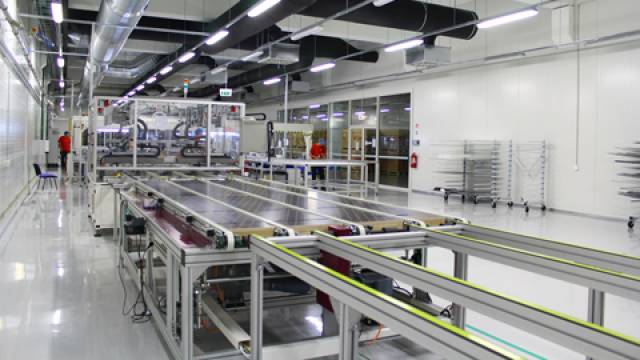New production line in Vilnius will manufacture photovoltaic elements for building facades.
As part of the European Union’s SmartFlex project, a new 37 million EUR production line has been completed in Vilnius, Lithuania that will manufacture custom-made photovoltaic elements for the facades of buildings.
The 50 megawatt capacity factory owned by SmartFlex project partner Via Solis will manufacture PV elements of varying shapes and colors on an industrial scale that can be used in building and home construction. In addition to producing rectangular modules, the production line can create square, triangular and round modules in any color in the European RAL color matching system.
“Architects repeatedly find that their designs for solar facade elements are either technically impossible or too expensive to implement,” notes Rimvydas Karoblis, CEO of Via Solis. “Our production line is set to change this and will even allow unusual solar facades to be constructed.”
The factory is able to produce modules measuring up to 1.7 meters by 3.5 meters with a maximum output of 750 watts peak. A variety of colors are created by using differently colored module glass, laminating films or solar cells. The glass may also be screen printed, while digital printing technology can also be used to apply a photo to the entire facade.
“Via Solis uses the colored, semi-transparent solar glass that has been developed by the innovative glass manufacturer Glassbel and is already used in standard glass facades,” says Juras Ulbikas from the Applied Research Institute for Prospective Technologies (ProTech) in Vilnius, who is coordinating the SmartFlex project. “The data relating to the required shapes, colors and sizes of the solar elements is directly transferred from the architect’s planning software to the production line.”
First, the front and rear glass panes of the module are cut to the necessary shape and size and a layer of PVB film is applied. Robots are used to position solar cells at desired intervals on the front glass pane in a process that also enables semi-transparent modules to be industrially manufactured. The procedure to connect the cells to form a string is also largely automatic. The second layer of PVB film is then applied, the rear glass pane is put in place and the module is laminated.
The European Union’s Seventh Framework Programme for Research and Innovation is contributing 2.9 million EUR in funding to SmartFlex. In addition to Via Solis, Glassbel and ProTech, project partners include the Photovoltaik-Institut Berlin, the mechanical engineering company Mondragon Assembly, the Swiss BiPV Competence Centre (SUPSI), planning software developer Creative Amadeo and specialist renewable energy agency Sunbeam Communications.
For more information, visit: www.smartflex-solarfacades.eu




